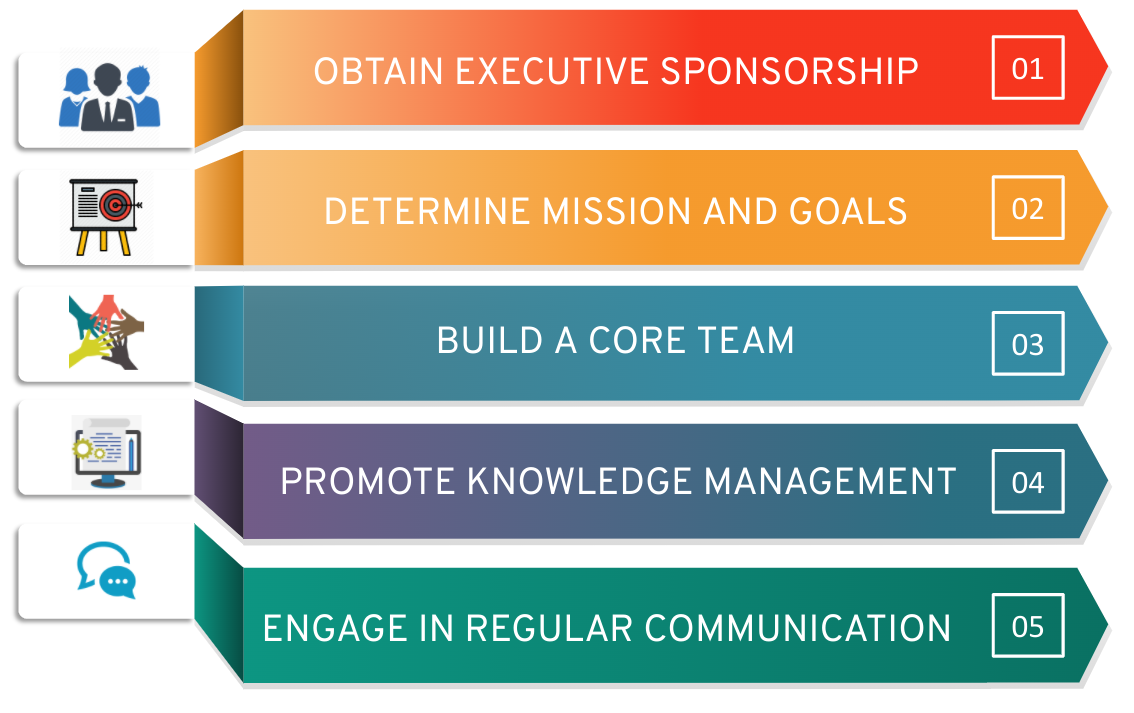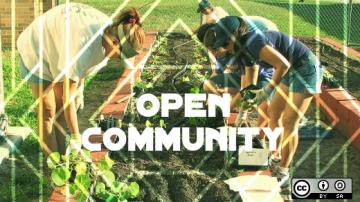In the first part of this series, we defined community as a fundamental principle in open organizations, where people often define their roles, responsibilities, and affiliations through shared interests and passions, not title, role, or position on an organizational chart. Then, in the second part of the series, we explored the many benefits communities of practice bring to open organizations—including fostering learning, encouraging collaboration, and offering an opportunity for creative problem-solving and innovation.
Now you know you'd like to start a community of practice, but you may still be unsure where to start. This article will help define your roadmap and build a plan for a successful community of practice—in five simple steps (summarized in Figure 1).

Figure 1: Steps for creating a community of practice
Step 1: Obtain executive sponsorship
While having a community manager focused on the day-to-day execution of community matters is important, an executive sponsor is also integral to the success of the community of practice. Typically, an executive sponsor will shoulder higher-level responsibilities, such as focusing on strategy and creating conditions for success (rather than implementation).
An executive sponsor can help ensure the community's goals are aligned with the overall strategy of the organization. This person can also communicate those goals and gather support for the community from other senior executives (potentially instrumental in securing financial support and resources for the community!).
Finding the right sponsor is important for the success of the program. An executive leader committed to fostering open culture, transparency, and collaboration will be very successful. Alternatively, you may wish to tap an executive focused on finding new ways to grow and reskill high-potential employees.
Step 2: Determine mission and goals
Once you've established a vision for the community, you'll need to develop its mission statement. This is critical to your success because the mission begins explaining how you'll achieve that vision. Primarily, your community's mission should be to share knowledge, promote learning in a particular area, and align that work with organizational strategy. However, the mission statement may also include references to the audience that the community will serve.
Here's one example mission statement:
To identify and address needs within the cloud infrastructure space in support of the organization’s mission of defining the next generation of open hybrid cloud.
After articulating a mission like this, you'll need to set specific goals for achieving it. The goals can be long- or short-term, but in either case, you'll need to provide a clear roadmap explaining to community members what the community is trying to achieve.
Step 3: Build a core team
Building a core team is essential to the success of a community. In a typical community of practice—or "CoP," for short—you'll notice four main roles:
- CoP program manager
- CoP manager
- Core team members
- Members
The CoP program manager is the face of the community. This person is primarily responsible for supporting the managers and core teams by resolving questions, issues, and concerns. The program manager also guides new communities and evangelizes the communities of practice program inside the organization.
The CoP manager determines community strategy based on business and community needs. This person makes the latest news, content, and events available to community members and ensures that the CoP remains focused on its goals. This person also schedules regular meetings for members and shares other events that may be of interest to them.
The CoP core team is responsible for managing community collateral and best practices to meet the community's goals. The core team supports CoP manager(s) and assists with preparing and leading community meetings.
Members of a community attend meetings, share relevant content and best practices, and support the core team and manager(s) in reaching community goals.
Step 4: Promote knowledge management
Communities of practice produce information—and members must be able to easily access and share that information. So it's important to develop a knowledge-management system for storing that information in a way that keeps it relevant and timely.
Over time, your community of practice will likely generate a lot of content. Some of that content may be duplicated, outdated or simply no longer relevant to the community. So it's important to periodically conduct a ROT Analysis of the content validating that the content is not Redundant, Outdated, or Trivial. Consider conducting a ROT analysis every six months or so, in order to keep the content fresh and relevant.
A number of different content management tools can assist with maintaining and displaying the content for community members. Some organizations use an intranet, while others prefer more robust content management such as AO Docs or Drupal.
Step 5: Engage in regular communication
The secret to success in maintaining a community of practice is regular communication and collaboration. Communities that speak with each other frequently and share knowledge, ideas, and best practices are most likely to remain intact. CoP managers should schedule regular meetings, meet-ups, and content creation sessions to ensure that members are engaged in the community. It is recommended to have at least a monthly meeting to maintain communication with the community members.
Chat/messaging apps are also a great tool for facilitating regular communication in communities of practice. These apps offer teams across the globe the ability to communicate in real-time, removing some collaboration boundaries. Members can pose questions and receive answers immediately, without the delay of sending and receiving emails. And should the questions arise again, most messaging apps also provide an easy search mechanism that can help members discover answers.
Building your community
Remember: A community of practice is a cost-effective way to foster learning, encourage collaboration, and promote innovation in an organization. In The Open Organization, Jim Whitehurst argues that "the beauty of an open organization is that it is not about pedaling harder, but about tapping into new sources of power both inside and outside to keep pace with all the fast-moving changes in your environment." Building communities of practice are the perfect way to do just that: stop pedaling harder and to tap into new sources of power within your organization.








4 Comments